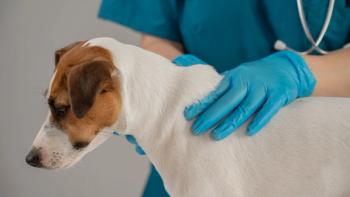
'Otitis again?' Solving those seemingly endless ear infections
An infection's recurrent nature stems from the many factors at play in your veterinary patients' poor sore ears. Here's what to note in the exam room to keep on top of it and stop the cycle.
Skipper joins you in an eyeroll that he's got an itchy ear--again. (Shutterstock.com)In her aptly named
Primary factors are those that initiate inflammation in the ear, such as parasites (e.g. Otodectes, Demodex or Sarcoptes species), foreign bodies (e.g. grass awns) and allergies (e.g. atopic dermatitis, food allergies), as well as less common issues like keratinization disorders, immune-mediated disease and neoplasia.
Next up come the secondary factors. These are the things you see on a daily basis in your ear patients by performing an ear cytology: bacterial or yeast infections, or even both-what Dr. Wilson calls “dermatology potpourri.”
Finally come in the perpetuating factors. This category of considerations is all about chronic inflammation or advanced changes such as stenosis or hyperplastic, over-reactive changes to the ear canal.
“Every time you see an ear infection, you don't need to think, ‘OK, primary, secondary or perpetuating?'” says Dr. Wilson. “But deep down, maybe you already are, because if we haven't addressed everything, it can definitely lead to complications. It's not really just a single treatment, but you're trying to intervene and prevent more chronic changes.”
Rechecks are an absolute must for these patients, whether it's their first case of otitis or their fifth. And whether you're a solo practitioner or in a multi-doctor practice, the records you keep on ear patients are essential. They can help either your future self or your fellow docs if they end up seeing the patient on follow-up. Here's what Dr. Wilson says needs to be recorded in the patient's chart:
• The ear pinna. “Is it lying flat?” asks Dr. Wilson. “Or have you guys had that cocker spaniel whose ears look like airplane wings?” She says clients often don't realize that's a sign of stenosis, mineralization and, often, pain. She asks clients to gently feel the hardening of their pet's ear (“It's turning to bone!”) to counter the chances that owners will dismiss it, as some owners of breeds like cocker spaniels tend to do: “Oh, it's a cocker. They always have bad ears.”
• The ear canal. What does the ear look like? How about the external canal? Can you see where the ear canal is? “I also describe the material. Is it brown? Is it yellow? Is it waxy? Is it creamy? This really helps me from one visit to the next to have some idea of how things look,” says Dr. Wilson.
• Physical exam and ear canal palpation. Dr. Wilson's cavalcade of questions she records for the next visit: Is the ear canal soft? Is it starting to be firm? Is it the left ear? The right? Is there any sort of pain with manipulation? Does the patient have a slight head tilt? Are you seeing any nystagmus or are you concerned about deeper ear involvement? What do you see on otoscopy or cytology? Cocci? Rods? Yeast? How about inflammatory cells? Are there any other concerning changes?
That question about whether there are inflammatory cells is important, says Dr. Wilson. You're used to seeing inflammatory cells with other dermatologic conditions, but it's actually unusual for ear cases.
“Think about a really nasty ear-it smells, you lift it up in the exam room and it's nasty,” she says. “If you smear that out, a lot of times you do not see inflammatory cells on an ear. When I do see them, I usually worry-do I have Pseudomonas? Pseudomonas can be more tissue-destructive, more painful, more inflammatory.”
If any of this leaves you slightly stressed to face your next ear case, Dr. Wilson says to remember this-it will keep you on task and not freaked out by the “scary black box” that is an ear. “There are times that if you step back and say, ‘OK, well, it's just skin. Maybe it's hyperplastic. What would I do for skin somewhere outside of the ear canal?' Sometimes that helps you focus on a plan and get a better understanding of what's going on.”
Newsletter
From exam room tips to practice management insights, get trusted veterinary news delivered straight to your inbox—subscribe to dvm360.




